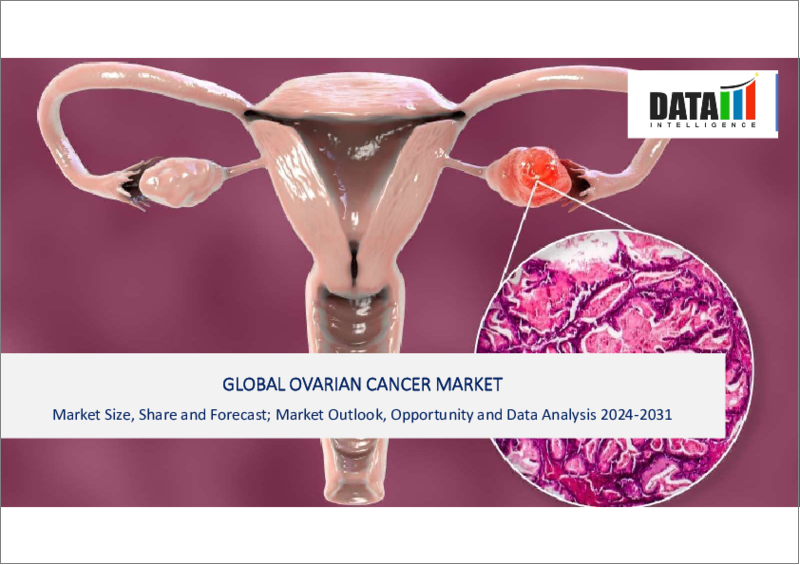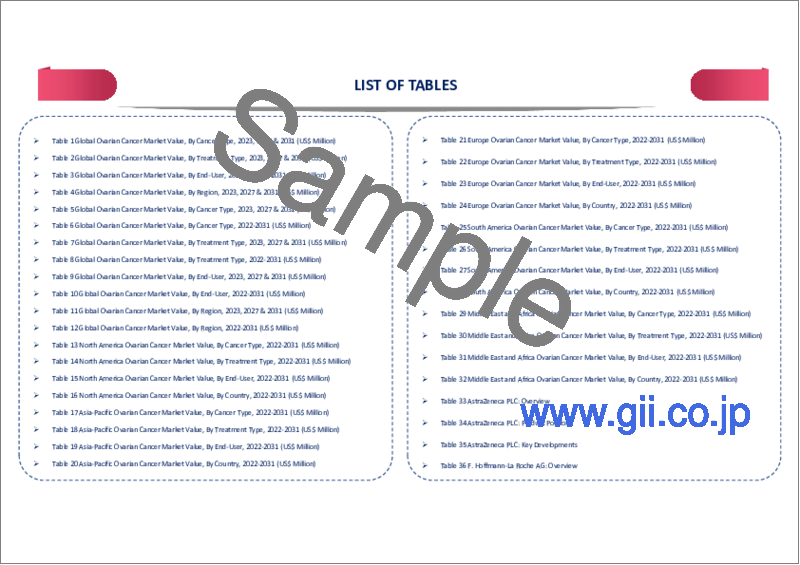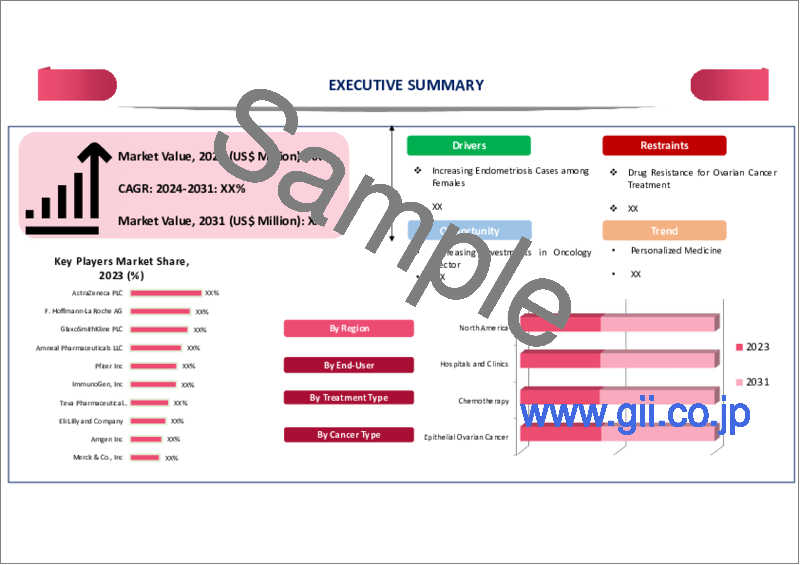|
|
市場調査レポート
商品コード
1345427
卵巣がんの世界市場-2023年~2030年Global Ovarian Cancer Market - 2023-2030 |
||||||
カスタマイズ可能
適宜更新あり
|
|||||||
| 卵巣がんの世界市場-2023年~2030年 |
|
出版日: 2023年09月06日
発行: DataM Intelligence
ページ情報: 英文 195 Pages
納期: 即日から翌営業日
|
- 全表示
- 概要
- 目次
概要
卵巣がんの世界市場は2022年に18億米ドルに達し、2023-2030年の予測期間中にCAGR 23.7%で成長し、2030年には82億米ドルに達すると予測されています。
卵巣がんは致命的な婦人科がんであり、世界で7番目に多い女性のがんです。卵巣がんに罹患した女性のほとんどは進行期で診断され、治療が最も困難です。卵巣がんの治療には通常、化学療法と手術が行われます。
卵巣がんの主な治療法は、手術と化学療法です。治療法は、がんの病期や悪性度などいくつかの要因によって異なります。卵巣がんは、外科的生検によってのみ確定診断が可能です。外科的デバルキング、放射線療法、化学療法は依然として主流の治療法です。
さらに、モノクローナル抗体は卵巣がんの免疫療法薬であり、標的治療薬でもあります。チェックポイント阻害剤も治療に用いられています。がん研究の進歩、女性における卵巣がんの有病率の増加、臨床試験の増加は、今後の市場を牽引するいくつかの要因です。
ダイナミクス
女性の子宮内膜症患者の増加
子宮内膜症は上皮性卵巣がん(EOC)の発症リスクを高めます。子宮内膜症と診断された若い女性は、子宮内膜症関連卵巣がん(EOAC)を発症するリスクが高いです。子宮内膜症の診断が遅れると腫瘍形成に直結し、深刻な事態を招くため、子宮内膜症歴のある女性は卵巣がんになりやすいです。
世界保健機関(WHO)の2023年3月号によると、子宮内膜症は世界の生殖年齢にある女性と女児のおよそ10%(1億9000万人)が罹患しています。現在、子宮内膜症の治療法は知られておらず、治療は通常、症状のコントロールを目的としています。
早期診断と効果的な子宮内膜症治療へのアクセスは不可欠ですが、低・中所得国を含む多くの環境では限られています。卵巣がんは、依然として女性の婦人科がんの中で最も死亡率の高いがんです。女性の76人に1人近くが生涯に卵巣がんを発症するリスクがあり、子宮内膜症はこれを5人に1人にわずかに増加させます。
パイプライン医薬品の増加
米国FDAは最近、卵巣がん治療薬として当社の主力製品に早期承認を与えたが、当社のパイプラインには開発中の新規ADCがいくつかあります。主要な医薬品開発企業は、卵巣がん治療の最前線で化学療法に取って代わる薬剤を徐々に開発するため、併用療法におけるリード薬剤の研究を進めています。
MIRASOLについては、FRα-高プラチナ耐性卵巣がんにおける単剤療法(無作為化確認試験)ポジティブなトップラインデータが2023年5月に報告されました。ジェネンテックには、アバスチン(ベバシズマブ)とポリADPリボースポリメラーゼ(PARP)阻害剤があります。アストラゼネカのリンパーザ(オラパリブ)、テサロのゼジュラ(ニラパリブ)、クロビス・オンコロジーのルブラカ(ルカパリブ)は、より標的を絞った治療や新しい作用機序(MOA)を持つ新規薬剤への道を開いています。GLORIOSAは、FRα-高プラチナ感受性卵巣がんにおけるミルベツキシマブ&ベバシズマブ維持療法とのダブル併用療法です。
薬剤耐性
卵巣がん治療における薬剤耐性は、腫瘍細胞が何らかの経路で化学療法薬に対して抵抗性を示すために増加しています。卵巣がんの伝統的な治療法はプラチナベースの化学療法(カルボプラチンまたはシスプラチン)とパクリタキセルの併用療法であり、過去20年間変わっていません。しかし、プラチナ製剤耐性のために、約80%の女性で再発が起こる。代謝経路のひとつは、卵巣がんを含む様々ながんにおける転移と薬剤耐性の重要な促進要因です。新規耐性メカニズムの発見と、ナノメディシンによる薬剤耐性を克服するアプローチが、まもなく紹介されます。
目次
第1章 調査手法と調査範囲
第2章 定義と概要
第3章 エグゼクティブサマリー
第4章 市場力学
- 影響要因
- 促進要因
- 女性の子宮内膜症患者の増加
- パイプライン医薬品の増加
- 抑制要因
- 薬剤耐性
- 機会
- 腫瘍学分野への投資の増加
- 影響分析
- 促進要因
第5章 産業分析
- ポーターのファイブフォース分析
- サプライチェーン分析
- 価格分析
- 規制分析
- ロシア・ウクライナ戦争の影響分析
- DMIの見解
第6章 COVID-19分析
第7章 タイプ別
- 上皮性卵巣がん
- 胚細胞性卵巣がん
- 間質細胞卵巣がん
- 小細胞卵巣がん
- その他
第8章 治療タイプ別
- 診断
- 画像検査
- 外科的検査
- その他
- 薬物/治療
- 標的治療
- 低分子薬
- モノクローナル抗体
- その他
- 免疫療法
- 化学療法
- PARP阻害剤
- 血管新生阻害剤
- PD-L1阻害剤
- その他
- その他
- 標的治療
第9章 エンドユーザー別
- 病院・クリニック
- がんセンター
- その他
第10章 地域別
- 北米
- 米国
- カナダ
- メキシコ
- 欧州
- ドイツ
- 英国
- フランス
- イタリア
- その他欧州
- 南米
- ブラジル
- アルゼンチン
- その他南米
- アジア太平洋
- 中国
- インド
- 日本
- オーストラリア
- その他アジア太平洋
- 中東・アフリカ
第11章 競合情勢
- 競合シナリオ
- 市況/シェア分析
- M&A分析
第12章 企業プロファイル
- AstraZeneca
- 企業概要
- 製品ポートフォリオと概要
- 財務概要
- 主な動向
- Roche
- GlaxoSmithKline
- Boehringer Ingelheim
- Bristol-Myers Squibb
- Novartis
- Celgene
- Amgen
- Pfizer
- Merck
第13章 付録
Overview
Global Ovarian Cancer Market reached US$ 1.8 billion in 2022 and is expected to reach US$ 8.2 billion by 2030 growing with a CAGR of 23.7% during the forecast period 2023-2030.
Ovarian cancer is a deadly gynecological cancer and is the seventh most common cancer in women globally. Most women with ovarian cancer are diagnosed at the advanced stage, which is most challenging to treat. Chemotherapy and Surgery are usually used in the treatment of ovarian cancer.
The main treatments for ovarian cancer are Surgery and chemotherapy. The treatment depends on several factors, including cancer stage and grade. Ovarian cancer can only be definitively diagnosed through a surgical biopsy. Surgical debulking, radiotherapy, and chemotherapy remain the mainstream treatment modalities.
Furthermore, monoclonal antibodies are considered both immunotherapy agents and targeted therapies for ovarian cancer. Checkpoint inhibitors are also used in the treatment. Rising advancements in cancer research, the increasing prevalence of ovarian cancer among females, and increasing clinical trials are a few factors that drive the market in the forthcoming period.
Dynamics
Increasing Endometriosis Cases among Females
Endometriosis increases the risk of developing epithelial ovarian cancer (EOC). Younger women diagnosed with endometriosis were at increased risk of developing endometriosis-associated ovarian carcinoma (EOAC). Females with an endometriosis history are more prone to ovarian cancer, as delayed diagnosis of endometriosis can directly lead to tumor formation, which leads to severe implications.
According to the World Health Organisation's March 2023 issue, endometriosis affects roughly 10% (190 million) of reproductive-age women and girls globally. There is currently no known cure for endometriosis, and treatment is usually aimed at controlling symptoms.
Access to early diagnosis and effective endometriosis treatment is essential but limited in many settings, including in low- and middle-income countries. Ovarian cancer remains the deadliest type of gynecological cancer in women. Nearly 1 in 76 women are at risk of developing ovarian cancer in their lifetime; endometriosis increases this slightly to 1 in 5.
Rising Pipeline Drugs
The US FDA recently granted accelerated approval to our lead product for treating ovarian cancer, and we have several novel ADCs in development in our pipeline. Major drug developers are investigating their lead agents in combination therapies to gradually progress into the front line of ovarian cancer treatment to replace chemotherapies soon.
MIRASOL, Monotherapy in FRα-High Platinum-Resistant Ovarian Cancer (Randomized Confirmatory Trial) positive top-line data reported MAY 2023. Genentech's Avastin (bevacizumab) and poly ADP-ribose polymerase (PARP) inhibitors. AstraZeneca's Lynparza (olaparib), Tesaro's Zejula (niraparib), and Clovis Oncology's Rubraca (rucaparib) are paving the way for more targeted therapies and novel agents with new mechanisms of action (MOAs). GLORIOSA, doublet with Mirvetuximab & Bevacizumab Maintenance in FRα-High Platinum-Sensitive Ovarian Cancer.
Drug Resistance
Drug Resistance for ovarian cancer treatment is increasing because of the tumor cell resistance to the chemotherapeutic drugs in some or other pathways. The traditional treatment for ovarian cancer is platinum-based chemotherapy (carboplatin or cisplatin) in combination with paclitaxel, and it has remained the same for the past two decades. Most patients are initially responsive to these treatments; however, relapse occurs in around 80% of women due to platinum resistance. One of the metabolic pathways is a crucial driver of metastasis and drug resistance in many different cancers, including ovarian cancer. Discoveries in novel resistance mechanisms and approaches to overcome drug resistance through nanomedicine shortly.
Segment Analysis
The global is segmented based on type, treatment type, end user, and region.
The Chemotherapy Segment Accounted for Approximately 54.3% of the Market Share
Epithelial cancer is the most common type of ovarian cancer. A large number of clinical research is ongoing. For instance, according to Cancer Research UK, about 90 out of 100 tumors of the ovary (90%) are epithelial, and according to the ClinicalTrails.Gov, over 200 interventional studies are active for epithelial ovarian cancer examples of a few are phase III randomized study evaluating Hyperthermic Intra-Peritoneal Chemotherapy (HIPEC) for treatment of relapse ovarian cancer,
A phase II pharmacological study with Wee-1 inhibitor MK-1775 combined with carboplatin in patients with p53 mutated epithelial ovarian cancer and early degeneration (< 3 months) or progression during standard first-line treatment, a GINECO phase II trial for the assessment of safety and the efficacy of the Bevacizumab, Olaparib and Durvalumab (MEDI 4736) combination in patients with advanced epithelial ovarian cancer in relapse, a phase 3, single-arm study of Mirvetuximab Soravtansine in platinum-resistant, advanced high-grade epithelial ovarian, primary peritoneal, or fallopian tube cancers with high folate receptor-alpha expression and many more.
Geographical Analysis
North America accounted for Approximately 39.1% of the Market Share in 2022
North America is predicted to command the global ovarian cancer market since North America has the highest prevalence of ovarian cancer and the largest portion of the global population. For instance, ovarian cancer ranks fifth in cancer deaths among women, accounting for more deaths than any other cancer of the female reproductive system. A woman's risk of getting ovarian cancer during her lifetime is about 1 in 78. Her lifetime chance of dying from ovarian cancer is about 1 in 108. The American Cancer Society estimates for ovarian cancer in the United States for 2023 over 20,000 women will receive a new diagnosis of ovarian cancer, and about 13,270 women will die from ovarian cancer.
Clinical trials are essential to improving cancer treatment, especially in highly lethal cancers like ovarian cancer. Major cancer organizations, including the National Comprehensive Cancer Network, American Society of Clinical Oncology, and Association of Community Cancer Centers, endorse that all cancer patients should consider and have the opportunity to participate in clinical trials. Black or African American patients comprised 8% of participants in clinical trials despite making up 14% of the US population. Similarly, Hispanics comprised 11% of participants in clinical trials but 18% of the US population.
COVID-19 Impact Analysis
The outbreak of the COVID-19 pandemic in late 2019 created unprecedented challenges for industries worldwide, including the global ovarian cancer market, as countries grappled with lockdowns, supply chain disruptions, and reduced economic activity.
The onset of the pandemic in early 2020 led to widespread lockdowns and restrictions, impacting drug development activities worldwide. The COVID-19 pandemic severely disrupted global supply chains, affecting the transportation of raw materials to pharmaceutical manufacturing industries.
The focus of research and development efforts shifted during the pandemic, with a significant emphasis on developing vaccines and treatments for COVID-19. This diversion of resources and attention may have temporarily impacted the progress of cancer-related research and development activities. This has led to delays in the completion of trials and the availability of new therapies, which has affected the market.
By Type
- Epithelial Ovarian Cancer
- Germ Cell Ovarian Cancer
- Stromal Cell Ovarian Cancer
- Small Cell Ovarian Cancer
- Others
By Treatment Type
- Diagnosis
- Blood Tests
- Imaging Tests
- Surgical Evaluation
- Others
- Drug/Therapy
- Targeted Therapy
- Small molecule Drugs
- Monoclonal Antibodies
- Others
- Immunotherapy
- Chemotherapy
- PARP Inhibitors
- Angiogenesis Inhibitors
- PD-L1 Inhibitors
- Others
- Others
By End User
- Hospitals and Clinics
- Cancer Centers
- Others
By Region
- North America
- U.S.
- Canada
- Mexico
- Europe
- Germany
- U.K.
- France
- Spain
- Italy
- Rest of Europe
- South America
- Brazil
- Argentina
- Rest of South America
- Asia-Pacific
- China
- India
- Japan
- Australia
- Rest of Asia-Pacific
- Middle East and Africa
Key Developments
- In January 2023, TYVYT® has been included in the NRDL for two additional indications including gastric cancer and esophageal cancer. TYVYT® is the first and the only PD-1 inhibitor for gastric cancer in the NRDL, as well as the only PD-1 inhibitor for the first-line treatment of five high-incidence cancer types in the NRDL.
- In November 2022, ImmunoGen received FDA approval for ELAHERE (mirvetuximab soravtansine-gynx) for the Treatment of Platinum-Resistant Ovarian Cancer. The approval of ELAHERE is significant for patients with FRα-positive platinum-resistant ovarian cancer, which is characterized by limited treatment options and poor outcomes.
- In November 2022, Roche received FDA approval for VENTANA FOLR1 RxDx Assay as the first IHC-based companion diagnostic to identify ovarian cancer patients eligible for ELAHERE. ELAHERE is a first-in-class antibody-drug conjugate (ADC) therapy developed by ImmunoGen, Inc
Competitive Landscape
The major global players in the ovarian cancer market include: AstraZeneca, Roche, GlaxoSmithKline, Boehringer Ingelheim, Bristol-Myers Squibb, Novartis, Celgene, Amgen, Pfizer, and Merck among others.
Why Purchase the Report?
- To visualize the global ovarian cancer market segmentation based on type, treatment type, end user and region as well as understand key commercial assets and players.
- Identify commercial opportunities by analyzing trends and co-development.
- Excel data sheet with numerous data points of ovarian cancer market-level with all segments.
- PDF report consists of a comprehensive analysis after exhaustive qualitative interviews and an in-depth study.
- Product mapping available as Excel consisting of key products of all the major players.
The global ovarian cancer market report would provide approximately 53 tables, 54 figures, and 195 Pages.
Target Audience 2023
- Manufacturers/ Buyers
- Industry Investors/Investment Bankers
- Research Professionals
- Emerging Companies
Table of Contents
1. Methodology and Scope
- 1.1. Research Methodology
- 1.2. Research Objective and Scope of the Report
2. Definition and Overview
3. Executive Summary
- 3.1. Snippet by Type
- 3.2. Snippet by Treatment Type
- 3.3. Snippet by End User
- 3.4. Snippet by Region
4. Dynamics
- 4.1. Impacting Factors
- 4.1.1. Drivers
- 4.1.1.1. Increasing Endometriosis Cases among Females
- 4.1.1.2. Rising Pipeline Drugs
- 4.1.2. Restraints
- 4.1.2.1. Drug Resistance
- 4.1.3. Opportunity
- 4.1.3.1.1. Increasing Investments in Oncology Sector
- 4.1.4. Impact Analysis
- 4.1.1. Drivers
5. Industry Analysis
- 5.1. Porter's Five Force Analysis
- 5.2. Supply Chain Analysis
- 5.3. Pricing Analysis
- 5.4. Regulatory Analysis
- 5.5. Russia-Ukraine War Impact Analysis
- 5.6. DMI Opinion
6. COVID-19 Analysis
- 6.1. Analysis of COVID-19
- 6.1.1. Scenario Before COVID
- 6.1.2. Scenario During COVID
- 6.1.3. Scenario Post COVID
- 6.2. Pricing Dynamics Amid COVID-19
- 6.3. Demand-Supply Spectrum
- 6.4. Government Initiatives Related to the Market During Pandemic
- 6.5. Manufacturers Strategic Initiatives
- 6.6. Conclusion
7. By Type
- 7.1. Introduction
- 7.1.1. Market Size Analysis and Y-o-Y Growth Analysis (%), By Type
- 7.1.2. Market Attractiveness Index, By Type
- 7.2. Epithelial Ovarian Cancer
- 7.3. Germ Cell Ovarian Cancer
- 7.4. Stromal Cell Ovarian Cancer
- 7.5. Small Cell Ovarian Cancer
- 7.6. Others
8. By Treatment Type
- 8.1. Introduction
- 8.1.1. Market Size Analysis and Y-o-Y Growth Analysis (%), By Diagnosis
- 8.1.2. Market Attractiveness Index, By Diagnosis
- 8.2. Diagnosis
- 8.2.1. Introduction
- 8.2.2. Market Size Analysis and Y-o-Y Growth Analysis (%)
- 8.2.3. Imaging Tests
- 8.2.4. Surgical Examination
- 8.2.5. Others
- 8.3. Drug/Therapy
- 8.3.1. Targeted Therapy
- 8.3.1.1.1. Small Molecule Drugs
- 8.3.1.1.2. Monoclonal Antibodies
- 8.3.1.1.3. Others
- 8.3.2. Immunotherapy
- 8.3.3. Chemotherapy
- 8.3.3.1.1. PARP Inhibitors
- 8.3.3.1.2. Angiogenesis Inhibitors
- 8.3.3.1.3. PD-L1 Inhibitors
- 8.3.3.1.4. Others
- 8.3.4. Others
- 8.3.1. Targeted Therapy
9. By End User
- 9.1. Introduction
- 9.1.1. Market Size Analysis and Y-o-Y Growth Analysis (%), By End User
- 9.1.2. Market Attractiveness Index, By End User
- 9.2. Hospitals and Clinics
- 9.3. Cancer Centers
- 9.4. Others
10. By Region
- 10.1. Introduction
- 10.1.1. Market Size Analysis and Y-o-Y Growth Analysis (%), By Region
- 10.1.2. Market Attractiveness Index, By Region
- 10.2. North America
- 10.2.1. Introduction
- 10.2.2. Key Region-Specific Dynamics
- 10.2.3. Market Size Analysis and Y-o-Y Growth Analysis (%), By Type
- 10.2.4. Market Size Analysis and Y-o-Y Growth Analysis (%), By Diagnosis
- 10.2.5. Market Size Analysis and Y-o-Y Growth Analysis (%), By Drug Class
- 10.2.6. Market Size Analysis and Y-o-Y Growth Analysis (%), By Country
- 10.2.6.1. U.S.
- 10.2.6.2. Canada
- 10.2.6.3. Mexico
- 10.3. Europe
- 10.3.1. Introduction
- 10.3.2. Key Region-Specific Dynamics
- 10.3.3. Market Size Analysis and Y-o-Y Growth Analysis (%), By Type
- 10.3.4. Market Size Analysis and Y-o-Y Growth Analysis (%), By Diagnosis
- 10.3.5. Market Size Analysis and Y-o-Y Growth Analysis (%), By Drug Class
- 10.3.6. Market Size Analysis and Y-o-Y Growth Analysis (%), By Country
- 10.3.6.1. Germany
- 10.3.6.2. UK
- 10.3.6.3. France
- 10.3.6.4. Italy
- 10.3.6.5. Rest of Europe
- 10.4. South America
- 10.4.1. Introduction
- 10.4.2. Key Region-Specific Dynamics
- 10.4.3. Market Size Analysis and Y-o-Y Growth Analysis (%), By Type
- 10.4.4. Market Size Analysis and Y-o-Y Growth Analysis (%), By Diagnosis
- 10.4.5. Market Size Analysis and Y-o-Y Growth Analysis (%), By Drug Class
- 10.4.6. Market Size Analysis and Y-o-Y Growth Analysis (%), By Sales Channel
- 10.4.7. Market Size Analysis and Y-o-Y Growth Analysis (%), By Country
- 10.4.7.1. Brazil
- 10.4.7.2. Argentina
- 10.4.7.3. Rest of South America
- 10.5. Asia-Pacific
- 10.5.1. Introduction
- 10.5.2. Key Region-Specific Dynamics
- 10.5.3. Market Size Analysis and Y-o-Y Growth Analysis (%), By Type
- 10.5.4. Market Size Analysis and Y-o-Y Growth Analysis (%), By Diagnosis
- 10.5.5. Market Size Analysis and Y-o-Y Growth Analysis (%), By Drug Class
- 10.5.6. Market Size Analysis and Y-o-Y Growth Analysis (%), By Sales Channel
- 10.5.7. Market Size Analysis and Y-o-Y Growth Analysis (%), By Country
- 10.5.7.1. China
- 10.5.7.2. India
- 10.5.7.3. Japan
- 10.5.7.4. Australia
- 10.5.7.5. Rest of Asia-Pacific
- 10.6. Middle East and Africa
- 10.6.1. Introduction
- 10.6.2. Key Region-Specific Dynamics
- 10.6.3. Market Size Analysis and Y-o-Y Growth Analysis (%), By Type
- 10.6.4. Market Size Analysis and Y-o-Y Growth Analysis (%), By Diagnosis
- 10.6.5. Market Size Analysis and Y-o-Y Growth Analysis (%), By Drug Class
- 10.6.6. Market Size Analysis and Y-o-Y Growth Analysis (%), By Sales Channel
- 10.6.7. Market Size Analysis and Y-o-Y Growth Analysis (%), By Country
11. Competitive Landscape
- 11.1. Competitive Scenario
- 11.2. Market Positioning/Share Analysis
- 11.3. Mergers and Acquisitions Analysis
12. Company Profiles
- 12.1. AstraZeneca
- 12.1.1. Company Overview
- 12.1.2. Type Portfolio and Description
- 12.1.3. Financial Overview
- 12.1.4. Key Developments
- 12.2. Roche
- 12.3. GlaxoSmithKline
- 12.4. Boehringer Ingelheim
- 12.5. Bristol-Myers Squibb
- 12.6. Novartis
- 12.7. Celgene
- 12.8. Amgen
- 12.9. Pfizer
- 12.10. Merck
LIST NOT EXHAUSTIVE
13. Appendix
- 13.1. About Us and Services
- 13.2. Contact Us






